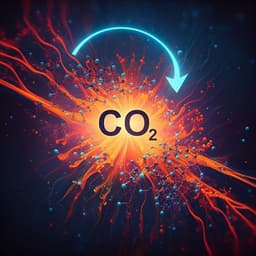
Chemistry
Integrating hydrogen utilization in CO₂ electrolysis with reduced energy loss
X. Jiang, L. Ke, et al.
Discover a groundbreaking approach to electrochemical carbon dioxide reduction that integrates CO2 electrolysis with hydrogen oxidation, achieved by researchers Xiaoyi Jiang, Le Ke, Kai Zhao, and others. This innovative method not only enhances selectivity and stability while reducing energy consumption but also showcases a promising future for sustainable energy solutions.
~3 min • Beginner • English
Introduction
The study addresses the high energy input and low efficiency barriers in low-temperature electrochemical CO₂ reduction (CO₂RR), especially the kinetically sluggish and energy-intensive oxygen evolution reaction (OER) at the anode that also induces severe carbon loss via CO₂ crossover and re-release at the anode. In typical anion-exchange membrane CO₂ electrolyzers, carbon loss can reach ~70%, and CO₂ recovery by amine scrubbing incurs 3–7 GJ per tonne CO₂, estimated to exceed the electrolysis energy by ~1.6×. Paired electrolysis strategies that replace OER with organic oxidations can reduce energy but suffer from market-size mismatch between CO₂-derived products and anodic coproducts and pose separation challenges. Given hydrogen’s central role as a renewable energy carrier and the fact that green hydrogen production via water electrolysis performs OER under more favorable thermodynamic and kinetic conditions (e.g., very low anodic overpotentials in SOEC/AWE), the authors hypothesize that integrating CO₂RR with hydrogen oxidation reaction (HOR) can lower overall energy consumption while mitigating carbon loss and catalyst poisoning. The purpose is to design and demonstrate a single-cell architecture coupling CO₂RR with HOR, using a Ni(OH)₂/NiOOH redox mediator to decouple reactions, minimize anodic losses, and quantify energy and polarization reductions relative to conventional CO₂RR.
Literature Review
Background literature highlights advances in CO₂RR catalysts and reactors achieving high-rate, selective conversion to C1–C3 products but constrained by energy efficiency due to OER. Prior paired electrolysis approaches oxidizing low-value organics (e.g., glycerol, alcohols, aldehydes) reduce anodic overpotentials and co-produce value-added chemicals, yet are limited by small market sizes compared to gigatonne-scale CO₂ utilization needs and by product separation complexity. Water electrolysis technologies (alkaline electrolyzers and solid oxide electrolysis cells) exhibit very low OER overpotentials under favorable conditions (e.g., ~0.01 V in SOEC and ~0.2 V in AWE at 50 mA cm⁻²), contrasted with >0.52 V in neutral CO₂RR cells. Techno-economic assessments indicate high energy penalties for CO₂ recovery from crossover and significant overall energy burdens in conventional systems. These insights motivate transferring the OER function from CO₂RR cells to dedicated water electrolyzers and pairing CO₂RR with HOR to achieve better kinetics and reduced system energy consumption.
Methodology
System design: A single electrochemical cell integrates CO₂RR at the cathode with a Ni(OH)₂/NiOOH redox mediator and HOR at the anode. The mediator decouples the cathodic CO₂RR from anodic HOR to avoid OER, carbon loss, and HOR catalyst poisoning.
Operating principle: Two alternating steps enable continuous operation.
- Step 1 (CO₂RR + Ni(OH)₂ oxidation, NIOR): At the CO₂RR gas-diffusion electrode (GDE), CO₂ is reduced to CO (CO₂ + H₂O + 2e⁻ → CO + 2OH⁻) or to formate (CO₂ + 2H₂O + 2e⁻ → HCOOH + 2OH⁻). At the mediator, Ni(OH)₂ is oxidized (Ni(OH)₂ + OH⁻ → NiOOH + H₂O + e⁻). Overall: CO₂ + 2Ni(OH)₂ → 2NiOOH + CO + H₂O or → 2NiOOH + HCOOH.
- Step 2 (NiOOH reduction + HOR): At the mediator, NiOOH is reduced (NiOOH + H₂O + e⁻ → Ni(OH)₂ + OH⁻), while the anode performs HOR (H₂ + 2OH⁻ → 2H₂O + 2e⁻). Overall: 2NiOOH + H₂ → 2Ni(OH)₂. This acts as a Ni–H₂ battery segment to harvest energy and offset Step 1 power.
Catalysts and electrodes: For CO₂-to-CO, Zn nanosheets were electrodeposited on Cu foam (samples Zn-Cu-100/500/1000 by deposition time) to form a high-surface-area CO-selective catalyst. For CO₂-to-formate, porous Bi₂O₃ nanospheres were synthesized via a carbon-templated hydrothermal route and calcination. A gradient functional layer was developed to transform the Zn-Cu-500 foam into a robust GDE: a layer-by-layer drop-cast carbon/PTFE composite (varying carbon:PTFE ratios) formed gas diffusion channels and ionic/electronic pathways, improving active site accessibility, mass transport, contact, and mechanical integrity. For OER controls, nanostructured Co₃O₄ on Ni foam was prepared by solvothermal growth and calcination. HOR used commercial Pt/C GDE.
Cell assembly: The custom cell comprised a CO₂RR GDE (1×1 cm²), a Ni(OH)₂/NiOOH mediator on Ni foam (2×2 cm²), and a Pt/C HOR GDE (1×1 cm²). A 1.5 cm PEEK frame separated CO₂RR GDE and mediator with a Hg/HgO reference. The mediator and HOR GDE were separated by a 130 μm porous separator pre-soaked in 1 M KOH. Both membrane-free and AEM-separated configurations were tested for gas collection and crossover studies.
Electrolytes and operating conditions: Step 1 used CO₂ feed (~35 mL min⁻¹) with circulating 1 M KOH or 1 M KHCO₃ at ~20 mL min⁻¹. Step 2 used 6 M KOH and H₂ feed (~10 mL min⁻¹) at the anode. Polarization curves were recorded after stabilization; no iR compensation in full-cell tests. Product analysis: Gas products quantified by GC; liquid products by NMR with DMSO internal standard; FEs computed from flow and concentration. Electrode kinetics and mechanisms were probed by LSV, CV, Tafel analysis, and EIS (charge-transfer and Warburg components). DEMS monitored O₂ evolution to confirm OER suppression during Step 1. Control experiments replaced NIOR with OER (Co₃O₄) and tested direct CO₂RR-HOR coupling without mediator to assess HOR catalyst poisoning via FTIR (COad on Pt).
Benchmarking hydrogen production: To incorporate upstream H₂ production energy, an alkaline water electrolyzer (AWE) and an electrode-supported SOEC were built and characterized to obtain their polarization behavior at 50 mA cm⁻² for system-level voltage and energy analyses.
Data analysis: Overpotential partitions for half-reactions were compiled to compare conventional CO₂RR (with OER) versus H₂-integrated CO₂RR + AWE or + SOEC. Energy consumption per tonne product was estimated with and without accounting for CO₂ recovery energy due to crossover in neutral media. Preliminary techno-economic assessment considered a 100 t d⁻¹ CO pilot plant, comparing capital costs and operational benefits (energy storage behavior and H₂ co-production).
Key Findings
- The H₂-integrated CO₂RR cell using a Ni(OH)₂/NiOOH mediator operates at <0.9 V at 50 mA cm⁻² and achieves high selectivity and stability for both gaseous and soluble products.
- CO₂-to-CO: In the H-cell, Zn-Cu-500 catalyst delivered CO Faradaic efficiency (FE) up to 85.8% at −1.0 V (vs RHE) with j_CO ≈ 11 mA cm⁻². In the integrated cell, CO FE reached 81.9% at 150 mA cm⁻². The cathodic performance was unaffected by replacing OER with NIOR, but overall cell voltage dropped by 0.15–0.20 V across 20–250 mA cm⁻² due to lower anodic overpotentials.
- CO₂-to-formate: Bi₂O₃ catalyst achieved formate FE ≈ 89.0% (H-cell) and ≈95.3% at 150 mA cm⁻² in the integrated cell. Cell voltages were 0.17–0.23 V lower than with OER at the same currents.
- Anode kinetics advantage: At 20 mA cm⁻², OER overpotential was ~330 mV versus ~40 mV for NIOR. NIOR showed lower onset potential and Tafel slope than OER (including Co₃O₄ benchmark). EIS indicated significantly smaller charge-transfer resistance for NIOR than OER (over an order of magnitude lower). OER initiated only after full conversion of Ni(OH)₂ to NiOOH (Depth-of-Charge 100%), evidenced by a sharp cell voltage rise and O₂ detection.
- OER suppression and carbon loss mitigation: Online GC and in situ DEMS detected no O₂ during Step 1 within specified current density ranges and mediator charge states, indicating effective OER suppression. The configuration allows easy retrieval of any crossed-over CO₂ without mixing with O₂.
- HOR catalyst protection: Direct CO₂RR-HOR coupling without the mediator initially reduced voltage but rapidly degraded due to Pt/C poisoning by CO and other CO₂RR products (formate, methanol, ethanol), confirmed by FTIR COad bands after ~300 s. The mediator decoupling eliminated HOR poisoning; no CO contamination on Pt/C after longevity testing.
- Step 2 performance: Ni–H₂ battery-like operation achieved maximum power density of 221 mW cm⁻²; steady galvanostatic voltage about −1.28 V at 20–50 mA cm⁻² with >95% voltage efficiency. Mediator Coulombic efficiency exceeded 99%.
- Stability: Multi-swap cycling at 50 mA cm⁻² for CO production showed no degradation over 10 cycles (CO FE 72 ± 1%). 100 h tests for both CO and formate showed trivial voltage decay (0.11–0.12 V) primarily in Step 1; GDE microstructures remained intact.
- System-level energy comparison at 50 mA cm⁻²: Equivalent operating voltages for CO₂-to-CO were 1.81 V (H₂-integrated + SOEC) and 2.30 V (H₂-integrated + AWE) versus 2.32 V for conventional CO₂RR. Summed overpotential losses for H₂-integrated + SOEC (ηsum ≈ 0.26 V) and + AWE (≈0.44 V) were lower than OER alone in conventional CO₂RR (≈0.47 V). Total polarization loss reduction up to ~22% and total energy consumption reduction up to ~42% when including upstream H₂ generation and CO₂ recovery energy in neutral conditions.
- Energy consumption per tonne CO: Conventional CO₂RR ~22.4 GJ t⁻¹; H₂-integrated + AWE ~22.2 GJ t⁻¹; H₂-integrated + SOEC ~17.5 GJ t⁻¹. Accounting for CO₂ recovery energy, both integrated systems show 27–42% lower energy consumption. The approach offers flexibility to generate CO or formate with high selectivity at practical current densities and prolonged stability.
Discussion
Transferring the anodic function from OER in CO₂RR to NIOR within a mediator and to OER in a separate water electrolyzer leverages more favorable reaction kinetics and conditions, thereby reducing anodic overpotentials and overall cell voltage. The Ni(OH)₂/NiOOH mediator decouples cathodic CO₂RR from anodic HOR, effectively suppressing OER and associated carbon loss while preventing HOR catalyst poisoning by migrated CO₂RR products. The approach maintains high CO₂RR selectivity and stability for both gaseous (CO) and soluble (formate) targets and achieves sub-0.9 V operating voltages at 50 mA cm⁻². System-level analyses, including upstream H₂ generation via AWE or SOEC, show lower operating voltages and energy consumption than conventional CO₂RR, with up to 42% energy savings when CO₂ recovery penalties are included. These findings confirm the hypothesis that coupling CO₂RR with HOR and transferring OER to a dedicated electrolyzer improves energy efficiency and operational robustness, offering a path to integrate CO₂ utilization with the hydrogen economy and grid-scale energy storage.
Conclusion
The work introduces a single-cell CO₂RR architecture that integrates HOR via a Ni(OH)₂/NiOOH redox mediator, achieving high selectivity (up to ~95% for formate; ~82% for CO at 150 mA cm⁻²), durable operation (>100 h), and markedly reduced operating voltages (<0.9 V at 50 mA cm⁻²). By suppressing OER at the anode and avoiding HOR catalyst poisoning, the system mitigates carbon loss and enhances efficiency. When accounting for hydrogen generation via AWE or SOEC, the H₂-integrated CO₂RR reduces total polarization and energy consumption relative to conventional CO₂RR, with up to 42% energy savings when CO₂ recovery is considered. Future research should target direct CO₂RR–HOR coupling without mediators by developing HOR catalysts resistant to CO₂RR product poisoning and by mitigating CO₂ crossover in neutral electrolytes, as well as extending the approach to other CO₂RR products and optimizing system integration for cost and performance.
Limitations
- The demonstrated system relies on a Ni(OH)₂/NiOOH mediator and alternating operation (Step 1/Step 2), adding complexity and periodicity; OER begins once the mediator is fully oxidized, necessitating timely swapping.
- Direct CO₂RR–HOR coupling without a mediator currently suffers from rapid HOR catalyst poisoning (e.g., Pt/C deactivation by CO and liquid products), indicating a need for poisoning-resistant HOR catalysts.
- CO₂ crossover in neutral/near-neutral conditions remains a challenge; although OER is suppressed and crossed CO₂ can be recovered more easily, comprehensive carbon balance and separation steps for soluble products were not fully addressed.
- Voltage efficiencies decrease at higher current densities; mass transport in complex nanostructured electrodes (e.g., Zn-Cu-500) may limit performance at high rates.
- Energy and techno-economic analyses are preliminary and scenario-dependent; capital costs increase due to the mediator and advanced water electrolyzer components.
- The study focuses on CO and formate as model products; generalization to multi-carbon products requires further validation.
Related Publications
Explore these studies to deepen your understanding of the subject.







